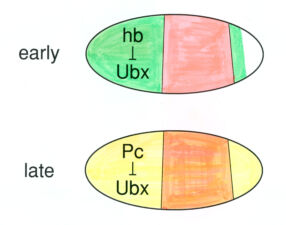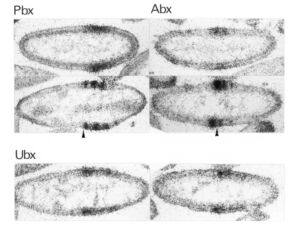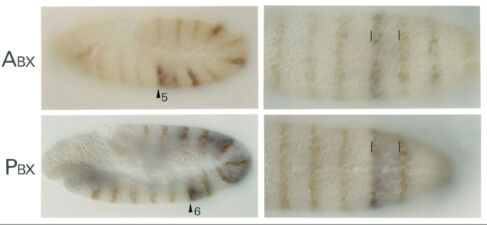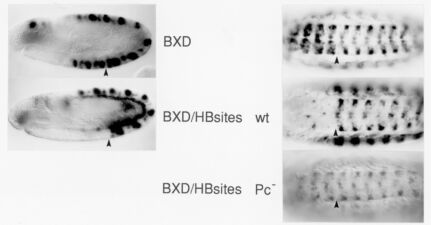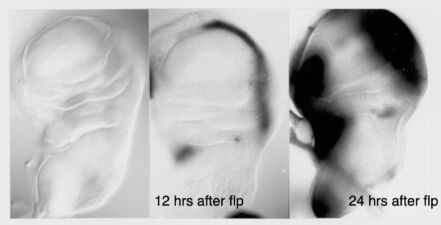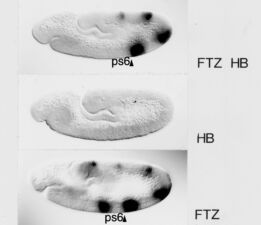When I started my own group in 1986 at the University of Zürich (Switzerland), I asked how developmental selector genes, such as the HOX genes Ultrabithorax, Abdominal-B and labial, are transcribed in response to positional information along the anteroposterior body axis of the embryo. Ultimately, this boils down to the question of how transcription factors bind to cis-acting control elements (transcriptional enhancers and silencers) to decode and respond to positional cues from within and outside cells. We used P-element transformation to insert reporters into the Drosophila genome comprising lacZ linked to short sections from the ~30kb upstream or ~45kb of intronic sequences of Ultrabithorax, as previous genetic analysis pointed to cis-acting control elements within these sequences. We thus discovered discrete segment-specific transcriptional enhancers that contain binding sites for positively-acting homeodomain proteins such as Fushi Tarazu and Even-skipped. We also identified silencers with binding sites for the Zn finger protein Hunchback, which acts in a hit-and-run fashion to promote recruitment of Polycomb complexes. Upon stable tethering to their cognate silencers, these complexes shut down Ultrabithorax permanently outside its normal realm of expression (e.g. at both ends of the anteroposterior body axis), whereby this OFF state is inherited throughout subsequent cell divisions.
When I arrived at the MRC Laboratory of Molecular Biology (LMB) in Cambridge in 1991, I reduced my group to four members (for space reasons), and thus decided to wind down the silencing work. Instead, we focussed our efforts on the transcriptional regulation of Ultrabithorax and labial in the embryonic midgut in response to positional signalling (see next paragraph). However, the silencing work was pursued by one of my first students, Jürg Müller and his team (at the Max Plank Institute of Biochemistry in Munich, Germany).
Image Gallery
Relevant references:
- Saari, G., Bienz, M. (1987)
The structure of the Ultrabithorax promoter of Drosophila melanogaster.
EMBO J 6(6): 1775-9 - DeLorenzi, M., Ali, N., Saari, G., Henry, C., Wilcox, M., Bienz, M. (1988)
Evidence that the Abdominal-B r element function is conferred by a trans-regulatory homeoprotein.
EMBO J 7(10): 3223-31 - Delorenzi, M., Bienz, M. (1990)
Expression of Abdominal-B homeoproteins in Drosophila embryos.
Development 108(2): 323-9 - Zhang, C.C., Müller, J., Hoch, M., Jäckle, H., Bienz, M. (1991)
Target sequences for hunchback in a control region conferring Ultrabithorax expression boundaries.
Development 113(4): 1171-9 - Müller, J., Bienz, M. (1991)
Long range repression conferring boundaries of Ultrabithorax expression in the Drosophila embryo.
EMBO J 10(11): 3147-55 - Ali, N., Bienz, M. (1991)
Functional dissection of Drosophila abdominal-B protein.
Mech Dev 35(1): 55-64 - Bienz, M. (1992)
Molecular mechanisms of determination in Drosophila.
Curr Opin Cell Biol 4(6): 955-61 - Christen, B., Bienz, M. (1992)
A cis-element mediating Ultrabithorax autoregulation in the central nervous system.
Mech Dev 39(1-2): 73-80 - Müller, J., Bienz, M. (1992)
Sharp anterior boundary of homeotic gene expression conferred by the fushi tarazu protein.
EMBO J 11(10): 3653-61 - Zhang, C.C., Bienz, M. (1992)
Segmental determination in Drosophila conferred by hunchback (hb), a repressor of the homeotic gene Ultrabithorax (Ubx).
Proc Natl Acad Sci U S A 89(16): 7511-5 - Castelli-Gair, J., Müller, J., Bienz, M. (1992)
Function of an Ultrabithorax minigene in imaginal cells.
Development 114(4): 877-86 - Busturia, A., Bienz, M. (1993)
Silencers in abdominal-B, a homeotic Drosophila gene.
EMBO J 12(4): 1415-25 - Christen, B., Bienz, M. (1994)
Imaginal disc silencers from Ultrabithorax: evidence for Polycomb response elements.
Mech Dev 48(3): 255-66 - Bienz, M., Müller, J. (1995)
Transcriptional silencing of homeotic genes in Drosophila.
Bioessays 17(9): 775-84 - Kehle, J., Beuchle, D., Treuheit, S., Christen, B., Kennison, J.A., Bienz, M., Müller, J. (1998)
dMi-2, a hunchback-interacting protein that functions in polycomb repression.
Science 282(5395): 1897-900
